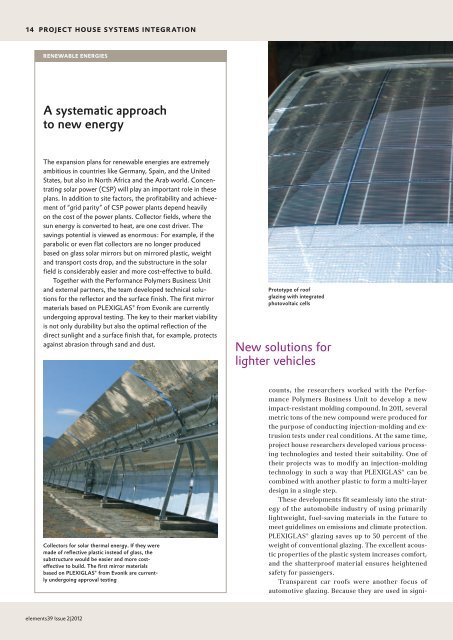Download - Evonik Industries
Download - Evonik Industries
Download - Evonik Industries
Create successful ePaper yourself
Turn your PDF publications into a flip-book with our unique Google optimized e-Paper software.
14 PRoJeCt HoUse sYsteMs InteGRAtIon<br />
ReneWABLe eneRGIes<br />
A systematic approach<br />
to new energy<br />
The expansion plans for renewable energies are extremely<br />
ambitious in countries like Germany, Spain, and the United<br />
States, but also in North Africa and the Arab world. Con centrating<br />
solar power (CSP) will play an important role in these<br />
plans. In addition to site factors, the profitability and achievement<br />
of “grid parity” of CSP power plants depend heavily<br />
on the cost of the power plants. Collector fields, where the<br />
sun energy is converted to heat, are one cost driver. The<br />
savings potential is viewed as enormous: For example, if the<br />
parabolic or even flat collectors are no longer produced<br />
based on glass solar mirrors but on mirrored plastic, weight<br />
and transport costs drop, and the substructure in the solar<br />
field is considerably easier and more cost-effective to build.<br />
Together with the Performance Polymers Business Unit<br />
and external partners, the team developed technical solu -<br />
tions for the reflector and the surface finish. The first mirror<br />
materials based on PLEXIGLAS® from <strong>Evonik</strong> are currently<br />
undergoing approval testing. The key to their market viability<br />
is not only durability but also the optimal reflection of the<br />
direct sunlight and a surface finish that, for example, protects<br />
against abrasion through sand and dust.<br />
Collectors for solar thermal energy. If they were<br />
made of reflective plastic instead of glass, the<br />
substructure would be easier and more costeffective<br />
to build. the first mirror materials<br />
based on PLeXIGLAS® from evonik are currently<br />
undergoing approval testing<br />
elements39 Issue 2|2012<br />
Prototype of roof<br />
glazing with integrated<br />
photovoltaic cells<br />
New solutions for<br />
lighter vehicles<br />
counts, the researchers worked with the Performance<br />
Polymers Business Unit to develop a new<br />
impact-resistant molding compound. In 2011, several<br />
metric tons of the new compound were produced for<br />
the purpose of conducting injection-molding and extrusion<br />
tests under real conditions. At the same time,<br />
project house researchers developed various processing<br />
technologies and tested their suitability. One of<br />
their projects was to modify an injection-molding<br />
technology in such a way that PLEXIGLAS® can be<br />
combined with another plastic to form a multi-layer<br />
design in a single step.<br />
These developments fit seamlessly into the strategy<br />
of the automobile industry of using primarily<br />
lightweight, fuel-saving materials in the future to<br />
meet guidelines on emissions and climate protection.<br />
PLEXIGLAS® glazing saves up to 50 percent of the<br />
weight of conventional glazing. The excellent acoustic<br />
properties of the plastic system increases comfort,<br />
and the shatterproof material ensures heightened<br />
safety for passengers.<br />
Transparent car roofs were another focus of<br />
automotive glazing. Because they are used in signi-
















